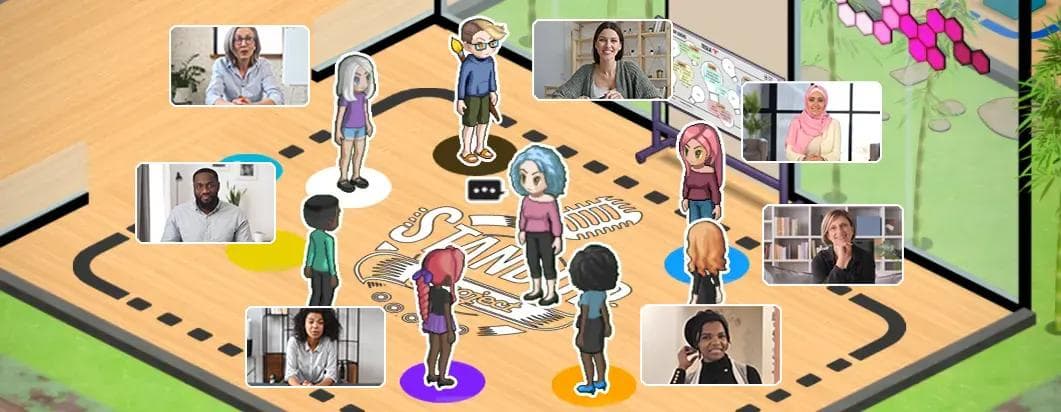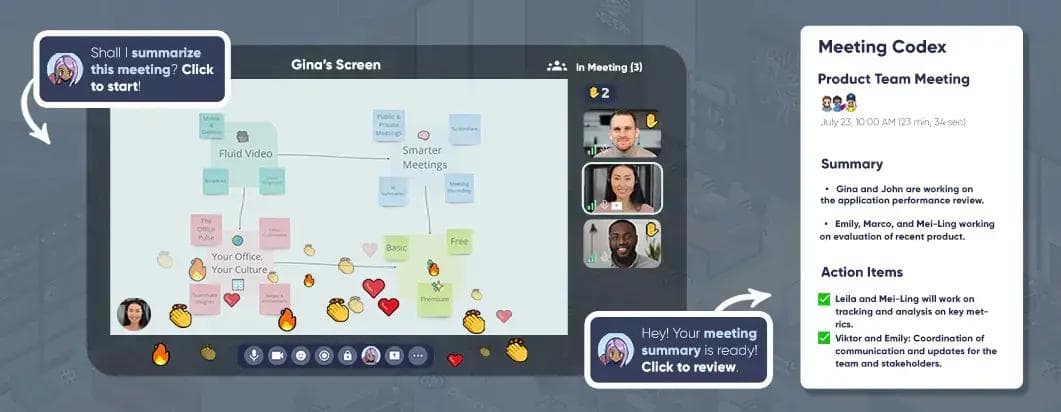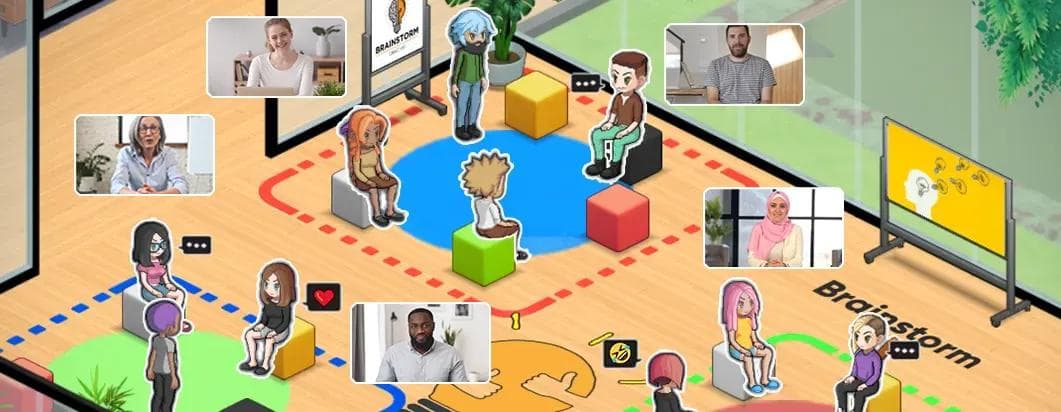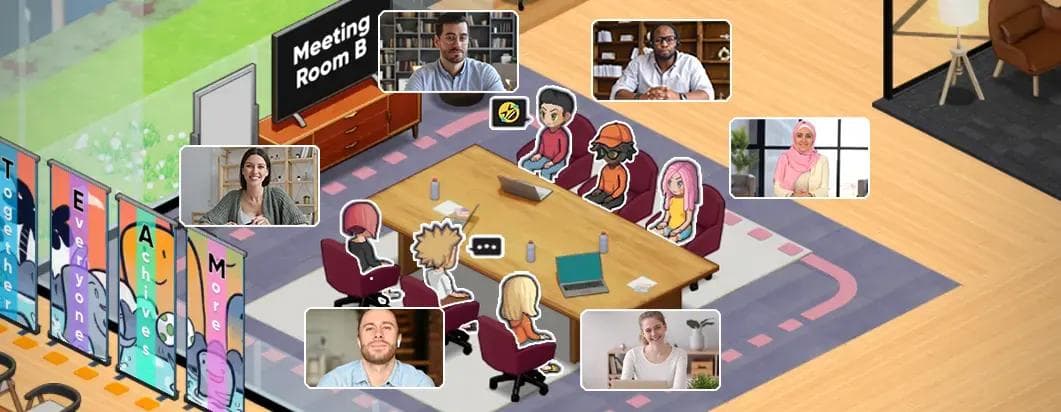SoWork Stand Up Meeting Template
Hold a remote stand up meeting your team will love. Feel like you're truly beside each other. And - thanks to AI-powered meeting tools - save hours of time, too.
About the Stand Up Meeting Template
The Daily Stand Up Meeting Template in SoWork is a simple path to an impactful and productive team meeting. Stand up meetings are regularly scheduled sessions where teammates share status updates on their work. During these meetings, team members speak about what they’re working on and if there’s anything blocking their progress.
Stand ups occur at many different kinds of companies, and provide an excellent platform for staying aligned and up to date with task progress. Also called a standing meeting, stand ups are meant to be quick, snappy and informative. They can be very effective for monitoring how your team is progressing toward their goals, getting transparency on what’s been completed and what’s left to do, and spotting any areas where plans need to be shifted.

4 Benefits of Using the Stand Up Meeting Template
1️⃣ Meeting Summaries via Sophia Bot, SoWork’s generative AI Office Assistant
With this Stand Up Template, you’re able to use SoWork’s AI generated Meeting Summaries (created by Sophia Bot). This Smart Office tool allows you to get the most out of your meeting by providing clear, section by section summaries and tidy action items. With SoWork’s Sophia Bot, you have your next priorities lined up right away, saving you time and energy.
When the meeting begins, click the Sophia Bot icon under your video tile - you’ll then see Sophia Bot begin typing. From here, your meeting content is being transcribed and summarized automatically, and a note with your Meeting Summary will be available to you and your team within minutes of leaving the meeting. You can access these notes at any point afterwards as they’ll be stored within your personal Meeting Summaries Codex on the SoWork app.

2️⃣ Feeling like you’re really together
With the SoWork Daily Stand Up Meeting Template, you’re able to collect early and linger around afterwards, because you’re in a virtual office! Your team can literally see that your design teammate is coming out of a deep work period and heading over to the meeting area, or that the engineering team is gathering around to discuss an upcoming release. This buzzing office energy fosters deeper connections, spontaneous conversations, and ideation that drives innovation, and just isn’t possible on a scheduled Zoom or Teams call.
Your team will truly feel like you’re sitting beside each other in a real office. You’re able to sit beside your favourite co-worker and grab people on the way out the door when the meeting ends. This feeling of togetherness is key for distributed and remote teams, helping your team feel aligned and ready to crush some work!
3️⃣ Smooth collaboration and team alignment
Stand ups allow your team to plan weeks effectively, see what still needs to be completed, and what’s already been done. They’re excellent for getting teammates on the same page about a project and ensuring everyone has full transparency on project status. In a stand up, you’re able to see if timelines need to be adjusted or if there’s anything impeding a teammate from getting their project done.
Do they need help reviewing some code? Do they have a question about some back-end complexities before they’re able to move forward? These questions get the whole team aligned, and set folks up for smooth hand-offs and collaborative sprints.

Further, it’s easier to highlight potential problems, like a pesky bug or catching something that’s out of scope. With this, the team can solve issues as quickly, and the project can move forward as planned. Surfacing this information regularly has a huge impact on velocity, and is key for high performing teams.
When these meetings are carried out well, the team becomes more inclined to communicate on tasks and projects. Teamwork like this gets multiple eyes on projects and tasks, helping everyone feel confident when offering assistance or solutions wherever they’re needed.
4️⃣ Monitoring your team’s workload
Another benefit of stand up meetings are maintaining a clear picture of what work your team has on their plate. Are they overloaded? Do they have room to take on a new project? If you’re finding that certain team members have too many tasks on the go, your team lead is able to get a good sense of what others are working on and if they can help out.
Redistributing the workload as needed leads to less stress and higher quality work across the board. Even more, stand ups are critical for assessing team needs in advance, and planning for when teammates are out on vacation. Another great way to maintain velocity and make sure no tasks are left behind.
How to Use the Stand Up Meeting Template
After clicking on the “Try Template” button, we’ll guide you through a quick onboarding flow, where we’ll make a virtual office. Your meeting template will be inside this office, and after onboarding, you’ll land in your template - ready to try it out with your team!
At SoWork, because we work beside each other in a virtual office, we’re able to see when people start gathering around before the meeting begins. So, when others in the office see their teammates collecting in the meeting area a few minutes early, they know they’re welcome to walk over and catch up. When the stand up begins, we jump in and follow our usual format.

With the Stand Up Meeting Template, you’re able to use SoWork’s AI generated Meeting Summaries (created by Sophia Bot). This Smart Office tool allows you to get the most out of your stand up by providing clear, section by section summaries and tidy action items. You'll have your next priorities lined up right away, saving you time and energy.
SoWork’s multitude of meeting related features make hosting meetings engaging and productive. You’re able to blast emojis - and even a teammate’s avatar - to celebrate progress, raise your avatar’s hand when you have a question (and lower it again when it’s been answered), screenshare multiple screens, use whiteboards together and so much more. You can also customize your Meeting Zone by adding relevant images and documents for your team to view before, after, or during your stand up.

FAQs
✨ How do I prep for my team’s stand up? ✨
To effectively prepare for your team’s stand up, decide on your meeting cadence, and ensure the meeting purpose and expectations are clear. The cadence of a stand up can vary quite a bit, so it’s best to choose whatever makes the most sense for you team, according to how your weeks are structured.
Do check-ins need to be daily? Does once a week make more sense for your team? A well regarded best practice is to hold stand ups at the same time and on the same day to reduce complexity.
In terms of time, morning is best as it sets up the day, and people can follow-up with each other later about blockers that arise. At SoWork, we begin each week with a priority planning session and goal setting regarding our tasks and commitments, then regroup on Friday to see if each teammate’s commitments were met.

When preparing for a stand up, it’s critical to ensure your team is aligned on the expectations of the meeting, for example, what level of detail to dive into, checking on the relative priority of tasks, and taking note of important things to discuss async or in a separate meeting - and creating an action item for this.
Going into a stand up meeting, every team member should know exactly what the stand up is for, and how they should structure their update. It’s advantageous to have a solid understanding of what you’re reporting on, what’s on your plate, relevant timeline estimates, and raise any high impact questions that would effect the direction of the task.
In SoWork, teammates can run up to each other before the meeting to get clarity before the meeting begins. Being able to collaborate with your team on the fly and ask questions when needed is super helpful for a smooth stand up.

✨ How do I get the most out of my team’s stand up? ✨
There are quite a few best practices for running a stand up meeting. It’s ideal when everyone who’s in the stand up works closely together. A good way to do this is to separate teams by what they’re working on (by goal, project, team type - design, engineering, marketing, etc.). This helps ensure that all of the information being shared is relevant to everyone.
Teammates should share the same things, in the same order, to allow for time to be maximized and better discernment of the topics at hand. Folks should address what they’re working on, when they expect it to be completed, and any issues or blockers they’ve faced or expect to face. With blockers, it’s essential to triage these right away, and ticket and note action items relating to these so they’re not forgotten.
It's not uncommon for team members to try and problem solve during the meeting, but it’s best to table conversations like this for later. Make a note of the issue(s), and then let the next person share their status update.
After the meeting disperses, this is when a meeting can happen to dig through the problem. Keeping stand ups short and punchy is key. These meetings should be quick, clear, and easy. In SoWork, that’s simple! Just breakout into groups afterwards, no meeting links or calendar invites required.